Treats for Lovebirds: A Comprehensive Guide
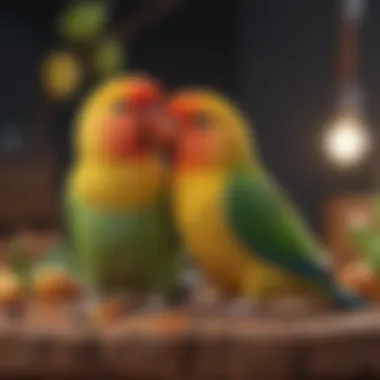
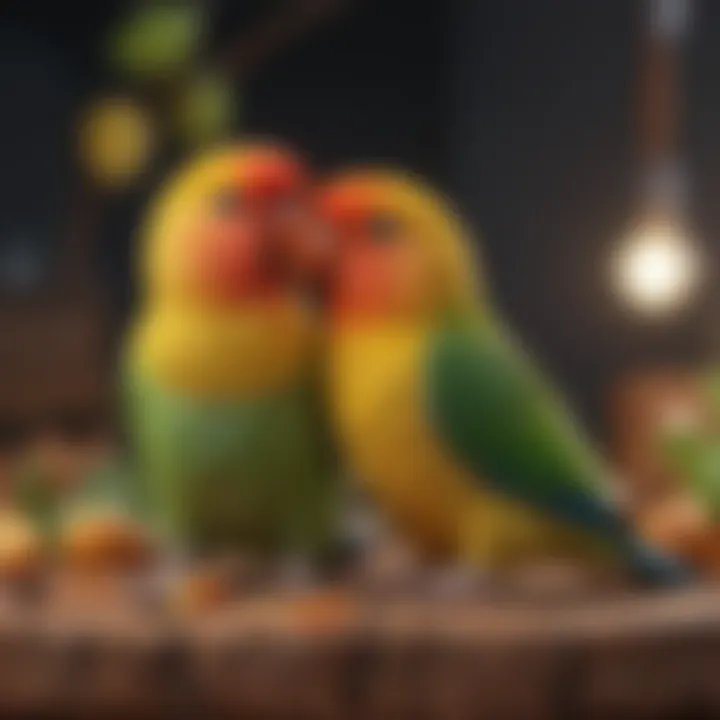
Intro
Selecting and preparing treats for lovebirds involves understanding their specific dietary needs and preferences. Lovebirds are small and social birds that require a balanced diet to thrive. Treats can enhance their quality of life when chosen wisely. The goal of this guide is to provide detailed insights into how to approach lovebird treats, focusing on nutritional importance, safe options, and practical preparation steps.
Pet Care and Grooming
Importance of Regular Care
Regular care is essential for maintaining the health and happiness of lovebirds. This includes daily activities such as feeding, cleaning their environment, and monitoring their behavior for any signs of distress or illness. A stable routine can help lovebirds feel secure, thus minimizing stress.
Grooming Techniques for Lovebirds
Grooming lovebirds includes feathers, nails, and beak care. Weekly inspection of their feathers helps identify any matting or potential health issues. Bathing your lovebird is also important as it promotes feather health. This can be done by providing a shallow dish of water or by misting them lightly with a spray bottle.
Tools and Products Recommendations
Using the right tools can make care easier. Some recommended products for lovebirds include:
- Bird bath: A shallow bowl for bathing.
- Nail clippers: Specifically designed for small birds.
- Perches of various textures to help keep their beaks and nails trim.
Seasonal Care Tips
Changes in seasons can affect lovebirds. In winter, ensure they remain warm and away from drafts. In summer, provide shade and fresh water to keep them hydrated. Always monitor their reactions to temperature changes.
Health and Nutrition
Understanding Pet Nutrition
Nutrition is crucial for the health of lovebirds. A balanced diet primarily consists of seeds, pellets, fruits, and vegetables. Each contributes to their overall well-being but requires attention to proportions.
Common Health Issues
Lovebirds can suffer from various health issues such as obesity and feather plucking. Understanding these common problems can lead to better preventative measures. Regular vet check-ups can help catch issues early.
Preventive Care and Regular Check-Ups
Establish a routine for checking your lovebird's health. Consult with a veterinarian specialized in avian care at least once a year. This will help you stay updated about any necessary vaccinations and health screenings.
Food and Dietary Advice
When incorporating treats, moderation is key. Treats should not exceed 10-15% of their overall diet. Suitable treats include small pieces of fruits like apples or vegetables like carrots. Always avoid processed human foods or those toxic to birds, such as avocados.
Engaging Activities and Enrichment
Fun Games to Play
Engagement is vital for the mental health of lovebirds. Simple games like hide-and-seek with treats or offering wooden blocks will stimulate their minds.
DIY Toys and Activities
Creating homemade toys can provide both fun and enrichment. Consider using materials like:
- Unbleached paper for shredding.
- Natural wood for chewing.
Importance of Mental Stimulation
Lovebirds thrive on interaction and stimulation. Daily activities should aim to keep them mentally active. Rotate their toys to maintain interest and engagement.
Outdoor Adventures and Exploration
If possible, experience outside environments. Supervised outdoor time in a secure cage can benefit them. New sights and sounds enhance their curiosity and happiness.
Resources and Community Engagement
Recommended Books and Websites
For deeper insight, consider these resources:
- Wikipedia for bird care details: Wikipedia - Birds
- Britannica for comprehensive articles on pet care: Britannica - Pet Care
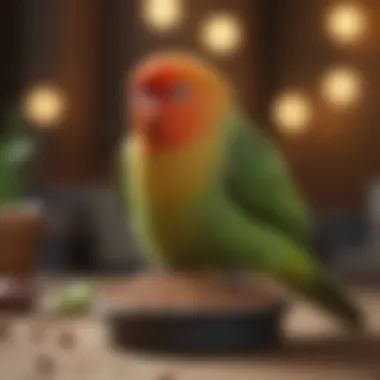
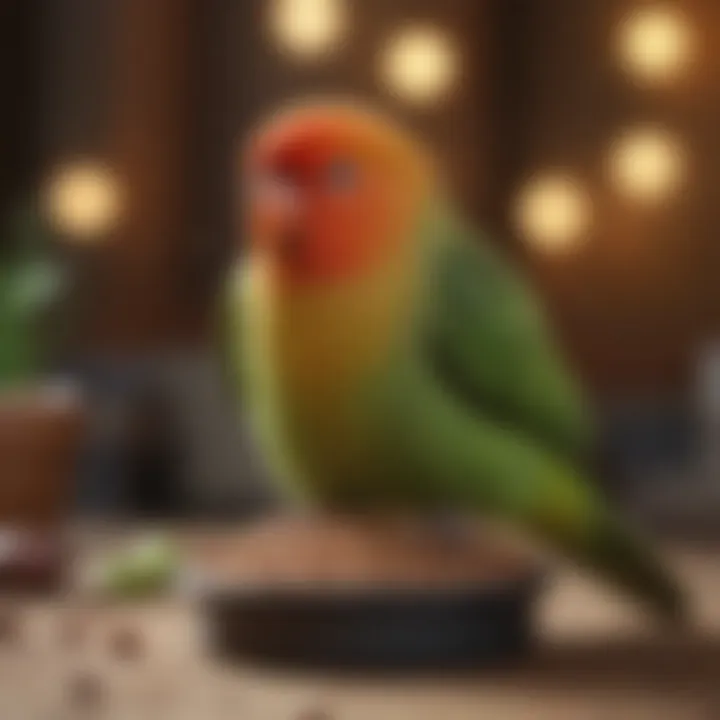
Forums and Groups for Pet Owners
Engaging with communities can provide support and information. Online forums like Reddit have various groups focused on pet care, where experiences and advice are shared. Check out Reddit - Lovebirds.
Finding Local Services and Classes
Explore local resources. Many communities offer classes on bird care. Also, search for avian veterinarians for specialized care.
Encouraging Community Sharing
Community sharing encourages learning and support among lovebird owners. Share your treats and care experiences to help others enhance their birds' lives.
Understand the needs of your lovebirds. Tailor their care and treat selection to foster a happy, healthy life.
Understanding Lovebird Nutrition
Understanding the nutritional needs of lovebirds is crucial in ensuring their health and well-being. Lovebirds are small birds, and their diet plays a significant role in their overall development. Their nutritional requirements are unique, necessitating careful consideration by pet owners. A proper understanding of these needs leads to healthier, more vibrant birds.
Lovebirds require a balanced diet consisting mainly of seeds, pellets, fruits, and vegetables. Each of these food types contributes essential nutrients that support various bodily functions. Additionally, knowledge about lovebirds' nutritional components enables owners to make informed decisions on the types of treats they can incorporate into their diets.
Essential Nutritional Components
The primary nutritional components essential to lovebirds include proteins, carbohydrates, fats, vitamins, and minerals. Each plays a specific role in maintaining their health.
- Proteins are integral for growth and tissue repair. They support feather development and overall well-being.
- Carbohydrates provide energy, allowing lovebirds to stay active and agile. Whole grains are an excellent source of carbohydrates.
- Fats also supply energy and are necessary for absorbing certain vitamins. However, the type of fats is important; unsaturated fats are preferable over saturated ones.
- Vitamins such as A, D, E, and K, as well as a range of B vitamins, aid in various physiological processes, including vision and immunity.
- Minerals like calcium and phosphorus are essential for bone health and metabolic processes. A balanced intake of these nutrients helps prevent health issues.
Incorporating a variety of foods ensures these essential components are available, creating a complete diet for the lovebirds.
Role of Treats in a Balanced Diet
Treats serve several important functions in the diet of lovebirds. While the primary focus should be on their staple foods, treats enhance the overall dietary experience and encourage enrichment.
Firstly, treats can foster bonding between lovebirds and their owners. When given in moderation, they can be used as rewards during training or simply as a way to show affection. Positive interactions like these contribute to the overall socialization of the bird.
Moreover, treats can introduce new flavors and textures. This variety prevents the diet from becoming monotonous, which is beneficial for a lovebird's mental stimulation. Providing fruits and vegetables as treats exposes lovebirds to essential vitamins not always found in their main diet.
However, it is crucial to keep treats balanced and not to overindulge. Over-treating can lead to health complications and an imbalanced diet. Moderation is necessary to maintain health and wellbeing.
Types of Treats for Lovebirds
Understanding the various types of treats for lovebirds is essential for their health and happiness. Treats provide not only enjoyment but also an opportunity to enhance nutrition. Choosing the right treats can help in reinforcing positive behaviors and maintaining a balance in your lovebird’s diet. When exploring treat types, consider nutritional value, ingredients, and the method of preparation.
Commercial Treat Options
Commercial treats for lovebirds are widely available and come in different forms. These treats are often designed to meet the nutritional needs of birds. You can find seed mixtures, pellets, and even fruit-infused options. Many brands like Kaytee and ZuPreem offer specialized products that cater to the unique requirements of lovebirds.
When selecting commercial treats, check the nutritional labels. Look for options with high-quality ingredients and minimal fillers. Avoid products that contain artificial preservatives or colors. It is important to remember that while commercial treats can be convenient, they should not replace a balanced diet. They should compliment your lovebird’s main food sources.
Homemade Treats: A Practical Approach
Preparing homemade treats can be a fulfilling experience. It allows you to control the ingredients and tailor the treats to your lovebird’s preferences. Basic recipes can include fruits, vegetables, and grains. For instance, you can create birdie bread using mashed bananas, oats, and a bit of flour. This is easy and nutritious.
Another idea is to mix diced carrots, bell peppers, and leafy greens. These offer vitamins and minerals essential for your lovebird’s health. Focus on using fresh produce. Avoid ingredients high in sugar and salt. Being consistent with treat preparation also helps establish a daily routine for your pet.
Natural Treats and Their Benefits
Natural treats present several benefits for lovebirds. Fresh fruits and vegetables are excellent options. Apples, carrots, and leafy greens can be given in moderation. They are vital for their hydration and provide essential nutrients. The lack of preservatives in natural treats makes them a healthier choice.
Unprocessed seeds and nuts can also serve as occasional treats. Hazelnuts, almonds, and sunflower seeds can enrich their diet, but should be given sparingly due to their high-fat content. Offering a variety of natural treats encourages foraging behavior, supporting mental stimulation and overall well-being. However, always ensure that any natural options are safe for consumption.
Selecting the Right Treats
Choosing the correct treats for lovebirds is an essential aspect of their care. The nature of treats goes beyond mere indulgence; it directly impacts their health and happiness. Selecting appropriate treats ensures a balanced diet that caters to the nutritional needs of your lovebird. Mistakes in treat selection can lead to health issues, so understanding the factors involved is crucial for any lovebird owner.
One of the primary elements in selecting the right treats is being aware of nutritional components. Treats should complement the staple diet, providing variety without excessive calories. Additionally, they should contribute to the lovebird’s overall wellbeing by adding essential nutrients.
Nutritional Labels and Ingredient Lists
When considering commercial treats, always scrutinize the nutritional labels and ingredient lists. Understanding these details is vital for making informed choices. Look for treats that list whole foods as the primary ingredients, such as grains, fruits, and vegetables. These components are crucial because they provide minerals and vitamins necessary for good health.
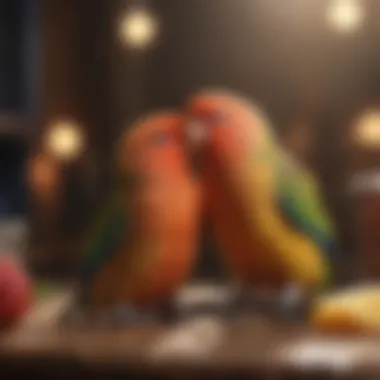
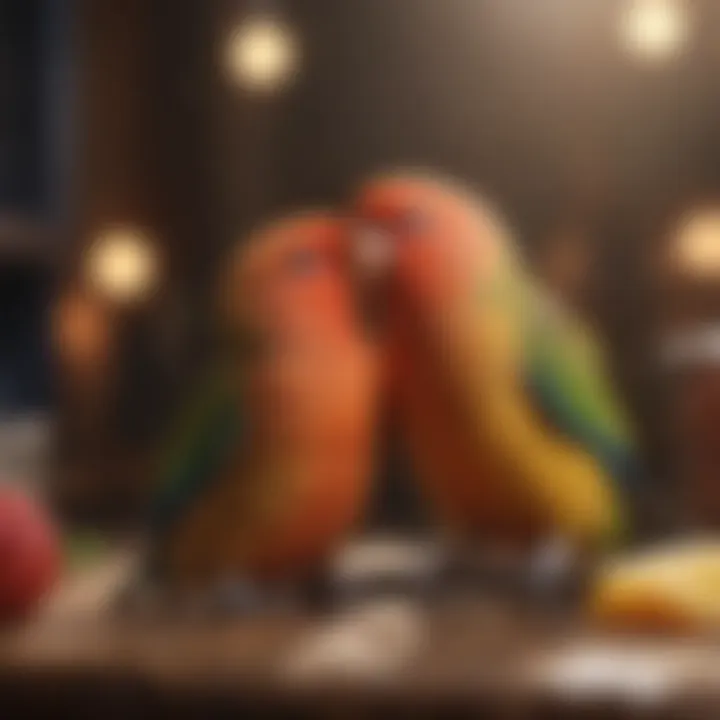
Pay careful attention to the following elements on the label:
- Guaranteed Analysis: This section provides information on the minimum and maximum levels of proteins, fats, and fiber.
- Ingredient Quality: Look for high-quality ingredients instead of fillers or artificial additives. The first five ingredients listed have the most significant impact on your lovebird’s diet.
- Manufacturing Standards: Knowing if the product meets specific industry standards can give you insight into its quality.
Checking these details allows you to ensure you are feeding your lovebird treats that support their health instead of compromising it.
Avoiding Harmful Ingredients
Avoiding harmful ingredients is a paramount concern when selecting treats. There are specific substances that can be detrimental to lovebirds’ health. Ingredients such as sugar, artificial preservatives, and coloring agents should be avoided. These materials can lead to various health issues, including obesity and digestive problems.
Be aware of the following harmful ingredients:
- High Sugar Content: Excess sugar can lead to obesity and diabetes, conditions that lovebirds are prone to.
- Artificial Additives: Ingredients like BHT or BHA are often used as preservatives but can cause adverse reactions in birds.
- Certain Nuts and Seeds: Some nuts, like macadamia and avocado, are toxic to birds and should never be offered as treats.
Always consult with a veterinarian to clarify which ingredients are safe and which are harmful. Their expertise can guide you in making the best choices for your lovebird's treats.
Ultimately, by carefully considering nutritional labels and avoiding harmful ingredients, you can enhance your lovebird's diet with treats that contribute to their health and happiness while also respecting their natural feeding instincts.
Homemade Treat Recipes
Homemade treats are an essential component of a lovebird's diet. Preparing these treats at home allows owners to control the ingredients and ensure the highest nutritional standards. When considering what lovebirds need, owners can choose fresh, wholesome ingredients that align with their specific dietary requirements. This not only benefits the health of the lovebirds but also adds a layer of interaction and bonding between the pet and owner.
Creating homemade treat recipes for lovebirds can also foster creativity. Owners can experiment with different combinations of ingredients that cater to their birds’ tastes. Moreover, homemade treats can be more economical than store-bought options that often include fillers and preservatives.
Fruits and Veggies Mix
A fruits and veggies mix serves as a versatile and tasty treat for lovebirds. Many fruits and vegetables offer essential vitamins and minerals. A well-made mix can keep the birds excited about their diet and provide variety.
Common choices include:
- Carrots: Rich in beta-carotene, which supports vision health.
- Broccoli: A source of vitamins C and K, beneficial for overall health.
- Berries (like strawberries or blueberries): Packed with antioxidants.
- Bananas: Provide potassium and are an appealing sweet option.
To prepare this mix, simply chop the fruits and veggies into small, manageable pieces. Mixing different colors and textures can make the treat visually appealing. Remember to wash all produce thoroughly and remove any pits or seeds, especially from fruits like cherries or peaches, as they can be harmful.
Grain-Based Treats
Grain-based treats can offer carbohydrate-rich nourishment that lovebirds need. These treats can be an excellent source of energy, particularly if they are made from whole grains. Common grains that are safe for lovebirds include:
- Oats: A great source of fiber and energy.
- Quinoa: Offers amino acids and is protein-rich.
- Brown rice: A filling grain that provides essential nutrients.
To make grain-based treats, cook the grains according to package instructions and mix them with minimal additional ingredients like a bit of fruit puree or seeds. You can form the mix into bite-sized pieces. As with all treats, moderation is important when serving these grain-based delights.
Nut-Based Snacks
Nut-based snacks provide healthy fats and protein. However, they should be given in moderation due to their high-caloric content. These snacks can be both nutritious and enticing for lovebirds. Suitable nuts include:
- Almonds: Rich in vitamin E and good for the skin.
- Walnuts: Contain omega-3 fatty acids beneficial for heart health.
- Pistachios: A fun treat due to their shells, promoting foraging behavior.
When preparing nut-based snacks, always ensure the nuts are unsalted and unseasoned. You can blend some nuts into a powder and mix them with fruits or grains to create a cohesive treat. Alternatively, you could also spread a thin layer of nut butter on whole-grain crackers. This will provide both a nutty flavour and nutritional value.
Always remember to check with a veterinarian when introducing new treats into your lovebird's diet to ensure their health and safety. Treats should complement their balanced diet, not replace it.
Portion Control and Moderation
Understanding portion control and moderation is crucial for maintaining your lovebird's health. Too many treats can lead to obesity and other related health issues. Pet owners must grasp how often and how much to give their birds to ensure a balanced diet.
When discussing treats, one needs to distinguish between treating as a reward and overindulgence. Treats should supplement the main diet, not replace it. This means they are to be considered as a small addition rather than the core of their nutritional intake. Establishing guidelines around treat size and frequency can be beneficial for long-term health management.
Determining Appropriate Serving Sizes
Serving sizes for treats depend on the lovebird's size and dietary needs. A general rule of thumb is to keep treats limited to about 10% of their daily food intake. For example, if you feed your lovebird a total of 30 grams of food each day, then no more than 3 grams should be treats. This helps to avoid excessive caloric intake while still allowing for occasional indulgence in flavorful snacks.
Moreover, consulting with a veterinarian before making significant changes to a lovebird's diet is also advisable. They can provide personalized recommendations based on your bird's age, activity level, and health condition.
Frequency of Treats in Daily Diet
The frequency at which treats are given is equally important as portion sizes. It is often recommended to offer treats a few times a week rather than every day. This schedule allows lovebirds to enjoy treats without compromising their standard nutrition. Treats can become special highlights in your bird's day rather than routine items.
In addition, diversifying treats can keep your lovebird stimulated and engaged. Alternate between fruits, veggies, commercial offerings, and homemade options. Rotate them weekly or bi-weekly to maintain interest while adhering to portion control. This method not only protects against over-treating but also encourages a varied diet, promoting better overall health.
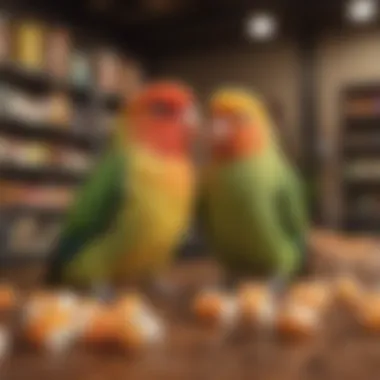
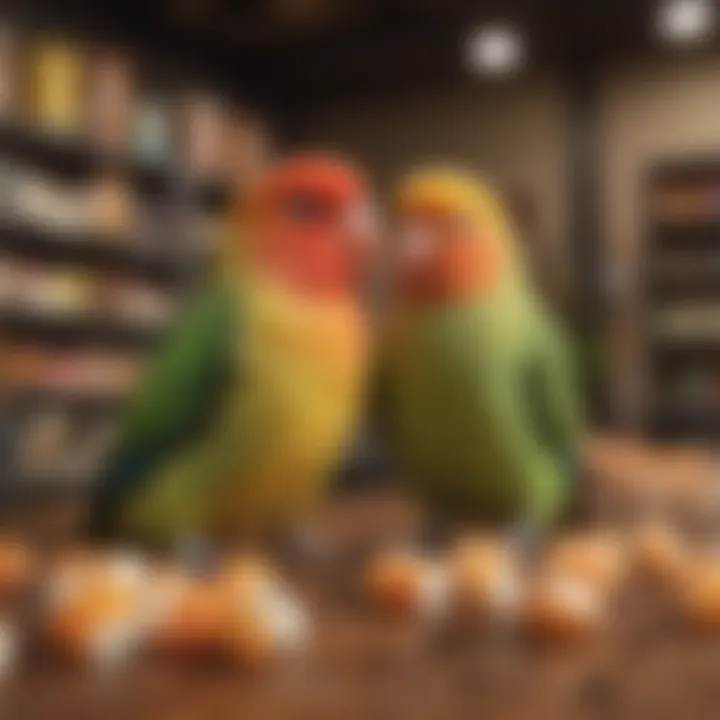
Remember: The purpose of treats is to enhance the bond between you and your lovebird and to promote good health. Moderation is key.
Training Lovebirds with Treats
Training lovebirds is essential for creating a trusting and engaging bond between bird and owner. Using treats during training sessions not only motivates lovebirds but also builds a positive association with the process. Lovebirds are intelligent creatures, and they benefit significantly from mental stimulation. Thus, employing treats as rewards can facilitate learning and enhance their natural behaviors. It’s vital to approach this training with patience and understanding, ensuring that it complements their well-being.
Using Treats as Positive Reinforcement
Positive reinforcement is a foundational training technique that involves rewarding a desired behavior to encourage its repetition. In the context of lovebirds, treats serve as an effective motivator. When a lovebird performs a command or trick successfully, rewarding with a favorite treat establishes a clear connection that encourages future compliance. This method enhances not only their skills but also strengthens the bond with their owner.
When selecting treats for reinforcement, variety is key. Mixing up different types of treats can prevent boredom and keep the lovebird engaged. Encourage participation with items like small pieces of apple, millet sprays, or commercially available lovebird treats. It is important to ensure that treats are nutritious and suitable, aligning with their dietary needs.
Monitoring Behavioral Changes
Monitoring how your lovebird responds to treats during training is crucial. Observing their excitement or reluctance can offer insights into their mood, motivation, and overall well-being. For instance, a lovebird that eagerly approaches training sessions with treats is likely feeling content and stimulated. On the other hand, a lack of interest in treats may indicate stress, illness, or dissatisfaction with the training technique or treat type.
Keeping a log of your bird's behavior can be helpful. This may include noting which treats they enjoy most, their responses to various commands, and any behavioral changes over time. By being attentive to these details, you can tailor your training approach accordingly. If certain treats consistently trigger positive responses, consider using them more frequently to reinforce desired actions. Also, be aware that while treats are an excellent reward, over-reliance on them can lead to problems.
Potential Risks of Over-Treating
When we talk about treats for lovebirds, it is crucial to emphasize the potential risks of over-treating. Lovebirds, like other pets, can suffer from health issues if their diet is not monitored properly. The treats that are often seen as simple rewards can turn into a significant part of their diet. Overindulgence can lead to various health complications, so understanding these risks is essential for any pet owner.
Health Implications of Excessive Treats
Excessive treats can cause several health issues in lovebirds. The most immediate concern is obesity. Lovebirds are small birds, and their caloric requirements are not very high. When treats make up a large portion of their intake, the balance of essential nutrients can become skewed.
- Obesity: This can lead to decreased mobility and further health problems, such as heart disease.
- Nutritional Deficiencies: With too many treats, lovebirds might not get the required vitamins and minerals from their staple diet.
- Metabolic Disorders: An unbalanced diet can lead to serious conditions, affecting their overall health.
Pet owners need to be mindful of the types of treats given. Treats high in sugar or fat should be particularly limited, as they offer little nutritional benefit.
Recognizing Signs of Dietary Imbalance
Recognizing the signs of dietary imbalance is vital for maintaining a healthy lovebird. When treats dominate their diet, lovebirds may exhibit various symptoms that indicate something is wrong.
- Weight Gain: Noticeable weight gain is often one of the first signs. Check your lovebird’s body condition to see if they maintain a healthy weight.
- Decreased Energy Levels: If your lovebird seems less active or has a reduction in playful behaviors, this could signal dietary issues.
- Feather Problems: Dull or dry feathers can indicate a lack of proper nutrients. A poor diet affects feather health significantly.
- Digestive Issues: Diarrhea or changes in droppings may also indicate a poor diet. These signs suggest that the bird is not absorbing nutrients effectively.
By being vigilant and recognizing these signs, pet owners can adjust their lovebird's diet accordingly before more serious health issues develop. > "A balanced diet is essential for the long-term health and well-being of your lovebird. Excessive treats can undermine this balance."
In summary, it is essential to treat all lovebird owners to be conscious of the potential health risks associated with over-treating. By balancing treats with their regular diet, you can help ensure your lovebird remains healthy and happy.
Social and Behavioral Aspects of Treats
The role of treats in the lives of lovebirds goes beyond mere nutrition. It touches on social interaction and the development of behaviors that enrich their lives. Treats can serve multiple functions, including fostering a bond between pet owner and bird, and promoting natural instincts that might otherwise remain dormant in a captive environment. Understanding these aspects can greatly enhance the experience of nurturing lovebirds.
Strengthening Bond with Your Lovebird
Creating a strong bond with your lovebird is vital. Treats are an effective way to establish trust and companionship. When a lovebird associates treats with positive experiences, it fosters a sense of safety and affection towards their owner. This affection can manifest in various ways, such as gentle nibbles, chirps of delight, or returning to your hand when you offer a treat.
In practice, consistency is key. Here are some points to consider:
- Use treats in a calm environment to prevent overstimulation.
- Offer treats gradually to make it a rewarding experience, rather than overwhelming.
- Observe how your lovebird responds and adjust accordingly by offering treats they particularly enjoy.
Such interactions can enhance both the mental well-being and happiness of your lovebird. They thrive on social feedback, and the bonds formed through treat-sharing can lead to a more interactive and engaging pet experience.
Encouraging Natural Foraging Behaviors
One of the intrinsic behaviors of lovebirds is foraging. In the wild, they spend much of their day searching for food, which also serves as a mental stimulus. By incorporating treats into their daily routines, owners can mimic this natural behavior.
Here are some strategies to encourage foraging:
- Hide Treats: Place treats in various spots within their habitat to stimulate exploration. Use safe materials like shredded paper or natural grass to hide treats to create a little challenge.
- Interactive Toys: Utilize foraging toys that demand effort to retrieve treats. This can include toys that dispense treats as the lovebird engages with them.
- Scatter Feeding: Scatter a mix of healthy treats throughout the play area. This not only encourages foraging but also enhances physical activity.
The act of foraging enriches your lovebird's environment. It engages their mind and caters to their natural instincts, leading to a healthier behavioral profile. Providing an opportunity for foraging can significantly reduce boredom and stress, fostering a happier pet in the long term.
Epilogue: Optimal Treating Practices
Developing a treatment regimen for lovebirds is crucial for their health and wellbeing. This conclusion section emphasizes various elements that contribute to an effective treat administration approach. By understanding the balance between nutrition, training, and social interaction, pet owners can significantly enhance their lovebird's quality of life.
The importance of optimal treating practices lies in maintaining a healthy bird. Treats do not just serve as snacks; they play a vital role in socializing, reinforcing good behaviors, and even mimicking natural foraging habits. Thoughtful selection and moderation should be at the forefront of any treatment strategy. Treats can enrich the lovebird's environment and promote an active lifestyle when used correctly.
Summary of Key Points
- Nutritional Balance: Treats must complement the primary diet of lovebirds, ensuring they receive adequate vitamins and minerals necessary for their health.
- Type of Treats: Selecting the right kinds of treats, whether commercial, homemade, or natural, is essential. Each type has its own benefits and considerations.
- Moderation: Excessive treating can lead to health issues like obesity or nutritional imbalances. Therefore, it is vital to understand serving sizes and frequency.
- Training and Bonding: Treats can be powerful tools for training. They can help in building a strong bond between the owner and their lovebird when used as reward mechanisms.
- Observation: Always monitor for signs that indicate a lovebird might be experiencing negative health effects due to overindulgence in treats or disinterest in their primary food.
Adhering to these key points ensures lovebirds lead healthy, engaging, and fulfilling lives.















